|
27th August 2017
Troon, Irvine Harbour
A Tweet reporting Mediterranean Gulls and
Long-tailed Duck at Meikle Craigs, Troon, tempted us to drive to the west coast
this week. The weather there was predicted to have been better than the in the
east, so it was all good. After our usual excellent Kilmarnock ASDA breakfast
we soon found ourselves picking our way through the inevitable dog walking
hordes to the rocky outcrop that is Meikle Craigs. The site we stopped to
observe was relatively free of walkers as they seemed to prefer to stay near to
the dunes. The tide was incoming so the birds were fairly active. A large
Herring Gull rested in a small rock pool close to a more skittish Black-headed
Gull which flew off as we got closer. Just 20m out we spotted the Long-tailed
Duck, probably female, diving repeatedly for long spells. It feeds on molluscs,
crustaceans and small fish and can dive to depths of 60m, although where it was
was certainly a lot shallower. A bit further out a half-dozen or so
Mediterranean Gulls were clinging to a large rock that was steadily
disappearing beneath the advancing tide.
Herring Gull
|
Black-headed Gull
|
Long-tailed Duck
|
Mediterranean Gull
|
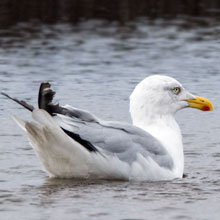
|

|
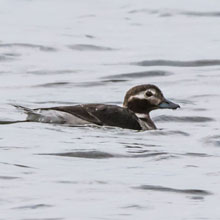
|
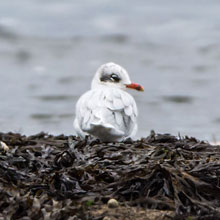
|
A local birder who had joined us,
and had the advantage of a large spotting scope, excitedly pointed out
a lone Peregrine Falcon perched way out atop the Craigs. It was seen
only for a few minutes but apparently it is a fairly regular visitor
according to the local. As we discussed the Falcon a sizeable flock of
small waders darted across our view. It was made up mainly of
Sanderling with a small number of Ringed Plovers and even fewer Dunlin.
The Plovers were easily distinguishable for the rest by their striking
black markings but the Sanderling and Dunlins are fairly similar, but
can be separated by their beak lengths; the Dunlin has a longer beak.
(Admittedly easier to see on the final photos!)
Peregrine Falcon
|
Sanderling
|
Ringed Plover
|
Dunlin
|
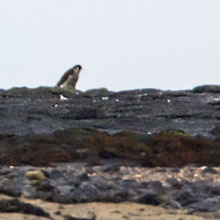
|
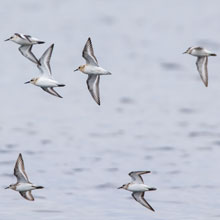
|
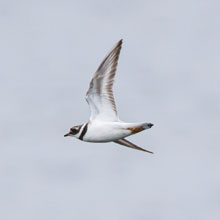
|

|
The familiar creaking cries of
Sandwich Terns started to fill the air. We struggled at first to locate
these small exciting diving birds but eventually we saw them on the
east side of the Craigs. Occasionally a few passed close enough for a
decent shot, although the light had been steadily getting dimmer. All
this time the advancing tide had been pushing us back further from the
Craigs so we decided to move round to the Harbour area car parks. These
give superb sea views and the rocks often throw up some delights such
as Sammy the Seal. As we sat scanning the rocks I noticed beside us a
patch of Lesser Burdock which was just coming into seed. It is commonly
mistaken for thistle but burdock has large heart-shaped leaves and
velcro-like hooks on its flower-heads. Also close by a clump of Common
Ragwort was host to a very busy pollen-coated White-tailed Bumblebee.
We sat transfixed by its efforts but every few minutes a Gannet passed
though never close enough for a really good shot.
Sandwich Tern
|
Lesser Burdock
|
White-tailed Bumblebee
|
Gannet
|
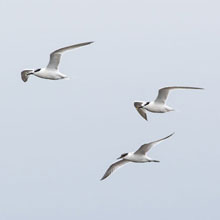
|
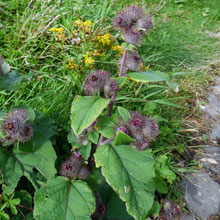
|
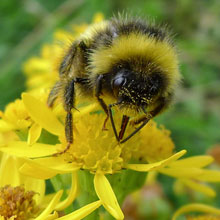
|
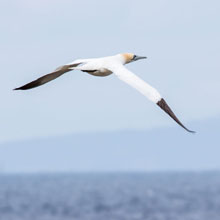
|
We went a short stroll along the
rocks hoping to see Sammy. He didn't show but we did get lovely views
of much-maligned Starlings, their iridescent plumages shining in the
strong sunlight that had at last decided to warm us. As we returned to
the car we had a final surprise when we caught sight of a solitary
female Wheatear dotting about the edge of the car park. This bird’s
name is derived from its white rump (or “white-erse”). Our final stop
was at Irvine Harbour. Before we had tea and pastries we went a short
walk to the mouth of the river where we came upon yet another female
Wheatear that came even closer (see Pictures of the Week” below). Just
as we were finishing our walk our wishes were finally granted when we
noticed a group of four seals in the distance on a platform in the
mouth of the River Garnock. Just a pity they were so far away. As a
final bonus, at my feet below the Harbour side railings from where we
were viewing the seals, I discovered a very small but attractive plant,
Henbit Deadnettle. It is probably native to the Mediterranean region
but has spread throughout much of the world. Its flowers and leaves are
edible and tastes similar to celery. A first for me.
Starling
|
Female Wheatear
|
Grey Seals
|
Henbit Deadnettle
|
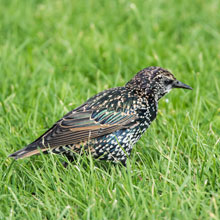
|

|
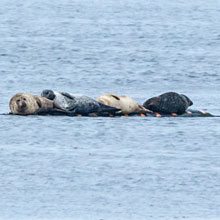
|
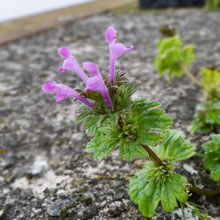
|
So our trip ended with a newby, and Sammy showed up with his pals, so our tea and pastries went down well.
Pictures of the week
Black-headed Gull
|
White-tailed Bumblebee
|
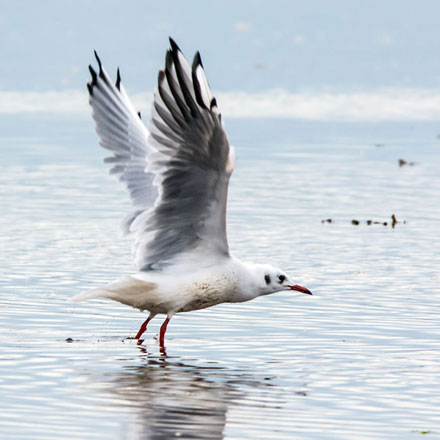
|
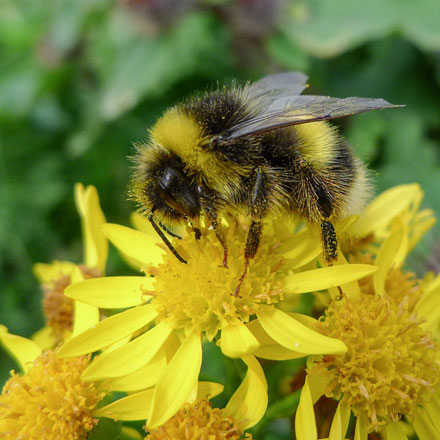
|
Starling
|
Female Wheatear
|
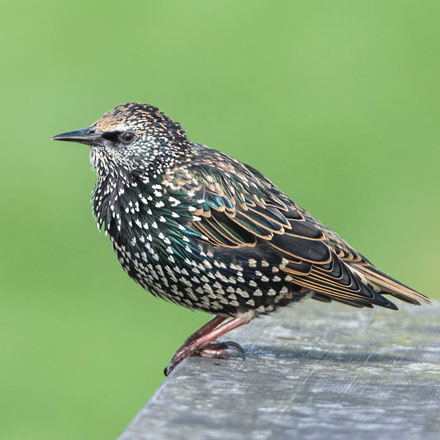
|
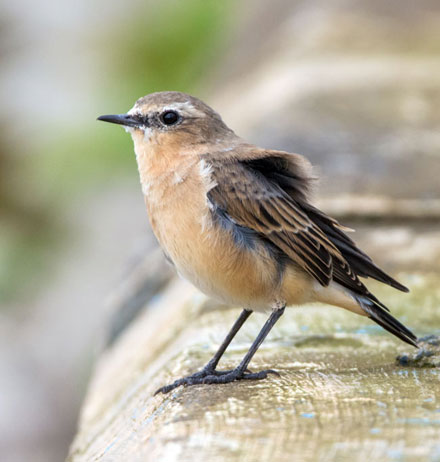
|
20th August 2017
Belhaven Bay, White Sands, Barns Ness
It was back to the Dunbar area this week. No particular target – we just
hadn't visited Belhaven for a few months and it can often throw up unexpected
goodies.
A pretty patch of Common Mallow was the first goody to catch our attention.
It is fairly common along the Lothian coastline. The tide was well out, but
coming in steadily. A Lesser Black-backed Gull and a Great Black-backed Gull
were standing 40m off the seawall. Identification tip: the “Lesser” has yellow
legs and a dark grey back while the “Great” has pink legs and a black back. A
few thin-looking Redshanks flew in away from a rampaging dog. They turned out
to be juveniles.
Common Mallow
|
Lesser Black-backed Gull
|
Great Black-backed Gull
|
Juvenile Redshank
|
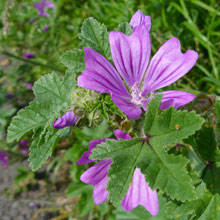 |

|
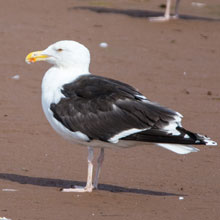
|
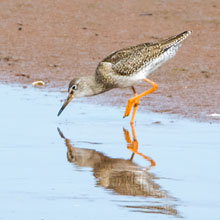
|
We arrived at Seafield Pond and
were disappointed to find there were relatively few birds. A couple of
Mallards were dabbling on the grass. Mallards are very common and are
consequently underrated – not by me though as I think they are very
good to look at. A juvenile Coot was trailing behind its parent on its
never ending quest for food. A young Grey Heron stood in the sunshine
silhouetted beside the reeds as a tiny Little Grebe was diving in the
middle of the pond.
Female Mallard
|
Juvenile Coot
|
Grey Heron
|
Little Grebe
|
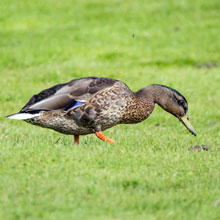
|
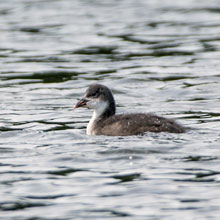
|
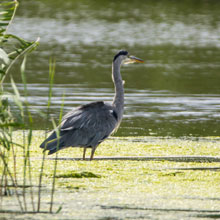
|
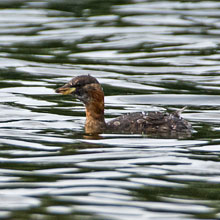
|
Another
Grey Heron flew in Suddenly, landing on top of Mallards who wrer
minding their own business on the raft in the centre of nthe pond. They
were no0ne too happy to have been disturbed.As we made our way back to
the seawall we disturbed a wee White Wagtail foraging by the pond side.
A pair of Wood Pigeons were surprisingly unconcerned by our presence as
they scoured the short grass for tasty m0orsels. We spotted a small
garden of wild flowers. As we went over to examine it we startled a
male Bullfinch that had been feeding there ( See Pictures of the Day
below )
Grey
|
Heron
|
Pied Wagtail
|
Wood Pigeon
|
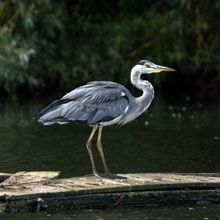
|
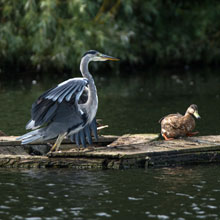
|
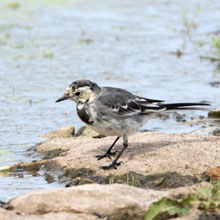
|
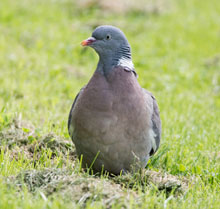
|
Beautiful blue Cornflowers were
dotted randomly throughout the garden. A pretty scarlet flower, as yet
unidentified, stood out beneath some Red Poppies. There were also large
blooms of Large Bindweed.
Cornflower
|
T.B.C.
|
Red Poppy
|
Large Bindweed
|
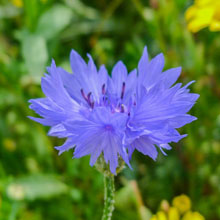
|
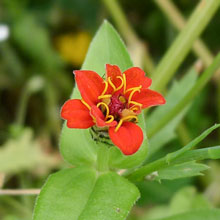
|
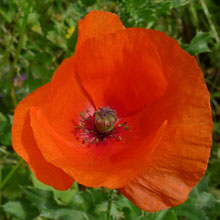
|
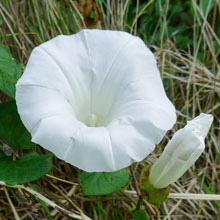
|
The garden, though wild, had the
look of the seed packed about it, but it didn't matter to the many
insects living there. Certainly the Buff-tailed Bumblebees were
single-mindedly flitting randomly from flower to flower. John spotted a
disabled Caddisfly crawling up a flower stem, one of its wings bent
sitting at an unnatural angle. Another type of bumblebee we saw were
Common Carder Bees – the only common UK bumblebee to be entirely brown
or ginger. A Common Green Capsid was probing the Corn Marigold is was
sitting on. This bug is not the gardeners pal though as it can damage
leaves and flowers in a number of way including injecting poisonous
fluid into the plants sap leaving the plant discoloured and distorted.
Buff-tailed Bumblebee
|
Caddisfly
|
Common Carder Bee
|
Green Capsid
|
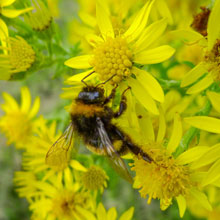
|
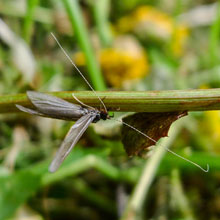
|
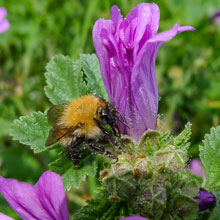
|
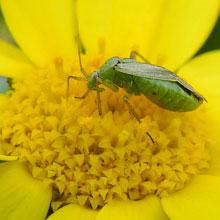
|
I had to look closely at another another Corn Marigold before I noticed a
Common Flower Bug. Its jazzy angled markings look to me as if they were painted
by modern artist. John was equally impressed by the markings of a Common Nettle
Tap moth which he thought had a purplish hue. Waiting, I dare say, to munch any
of these insects was a European Garden Spider. The grey and a bit hairy fly,
Helena Reversio, was dining on another Corn Marigold as if oblivious to the
8-legged threat only inches away.
Common Flower Bug
|
Common Nettle Tap
|
European Garden Spider
|
Fly- Helena Reversio
|
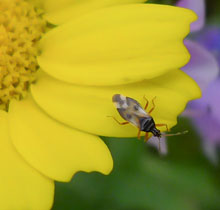
|
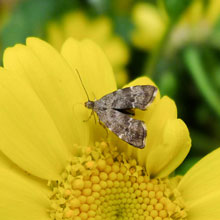
|
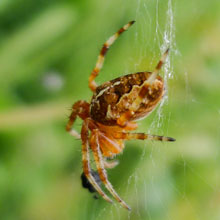
|
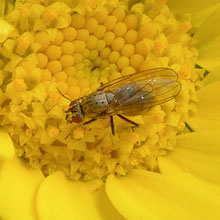
|
On yet another Corn Marigold the
handsome little hoverfly Syrphus Ribesii took a brief rest, allowing me
to record its image for this blog. As we moved back to the seawall we
passed a patch of Great Willowherb by the Pond. Other common names for
this tall plant include – great hairy willowherb, codlins-and-cream,
apple-pie and cherry-pie. Along the path we noticed many instances of
White Deadnettle whose leaves look very like the more common Stinging
Nettle, but without the sting – hence the name “dead” nettle. By now
seawater was up to the seawall. A Grey Heron stood motionless some 50m
away probably pondering its next move.
Hoverfly - Syrphus Ribesii
|
Great Willowherb
|
White Deadnettle
|
Grey Heron
|
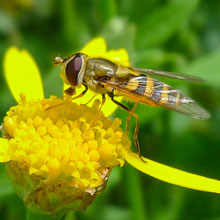
|
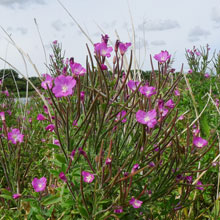
|
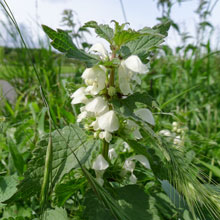
|
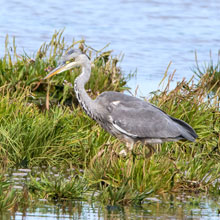
|
We picked up a message on Twitter
that a Marsh Harrier had been spotted by the nearby Whitesands. We
headed there quickly but we did not see said Harrier. However, I
managed to photograph a few more insects on the very plentiful Sea
Rocket. First a Buff-tailed Bumblebee, followed by Large White
butterfly and finally a Small Tortoiseshell. A fairly fresh-looking
Wall Brown butterfly got close enough for a couple of shots with my
long lens.
Buff-tailed Bumblebee
|
Large White Butterfly
|
Small Tortoiseshell
|
Wall Brown
|
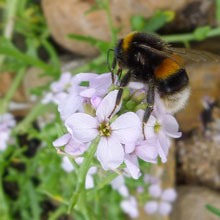
|
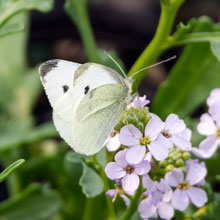
|
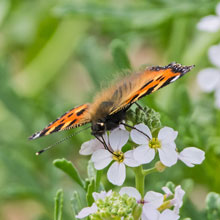
|
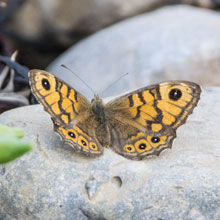
|
Disappointed with the lack of
birds we moved on a mile eastwards to Barns Ness. As we left the car
park I snapped another Large White butterfly on Creeping Thistle.
Nearby on some Yarrow I got a picture of a Small Copper butterfly.
Eventually we reached the sandy beach to the east of the lighthouse. We
sat there optimistically letting the birds come to us. A Ringed Plover
noticed us and winged it swiftly, followed by what we thought might be
a Golden Plover. We were still debating this when I noticed another
Golden Plover about 30m away. The Plover, a relative of the Lapwing, is
so-called as it was thought they appeared when it was going to rain -
“pluvia” is Latin for rain – hence “plover”.
Large White Butterfly
|
Small Copper
|
Ringed Plover
|
Golden Plover
|
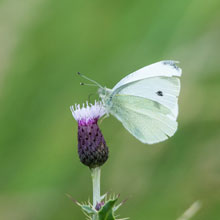
|
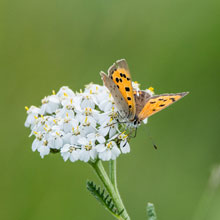
|
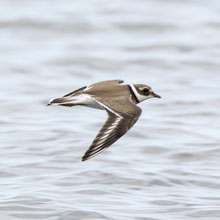
|
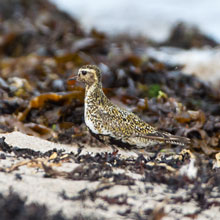
|
Satisfied, we set off back to the
car only to come upon large flocks of Curlew, Dunlin and Ringed Plover
brought close to dry land by the incoming tide. Amongst them we spotted
a couple of female Wheatears that were keeping us under surveillance as
we observed the waders.
Curlew
|
Dunlin
|
Ringed Plover
|
Female Wheatear
|
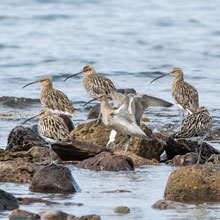
|
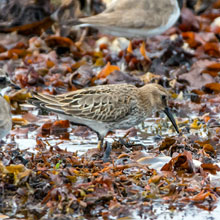
|
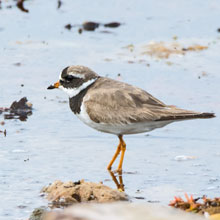
|
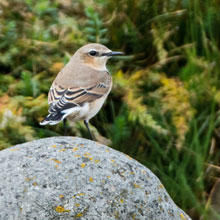
|
Back at
the car, over tea and Danish pastries, we were well-chuffed with our
collection of pictures. We certainly had a few goodies, some of which
were unexpected, such as the Golden Plover and the Bullfinch. Below are
some of our favourite images from the day.
13th August 2017
Musselburgh
Our destination of choice this week was Musselburgh. Twitter posts were
reporting there were Black-tailed Godwits, Greenshanks, Green Sandpipers as
well as lots of the more commonly seen birds.
We parked at the Esk mouth and set off in bright sunshine. I snapped an
image of some Common Mallow by the banks of the river. The leaves
contain
mucilage – glue-like sap that is a soothing agent in treating bites and
stings.
At the start of the promenade Perennial Sow Thistle and Yarrow plants
also
caught my attention. Yarrow is a powerful 'healing herb' used typically
for
wounds, cuts and abrasions. A scrawny Magpie sitting basking in a
neighbouring tree paid us no heed as we made our way east, heading for
the scrapes, Levenhall Links.
Common Mallow
|
Perennial Sow Thistle
|
Yarrow
|
Magpie
|
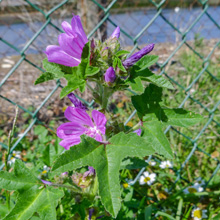 |
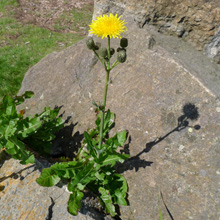 |
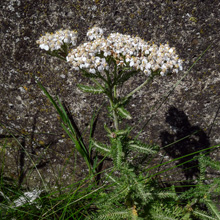 |
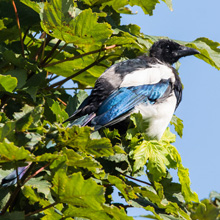 |
With flowers looking similar to Sow Thistle, an impressive, tall
Broad-leaved Hawkweed plant was next to be photographed. Beside it a tatty
Meadow Brown butterfly flitted into view and came to rest on some grass where I
managed a quick shot. Next, a female Linnet sat perched on a rock below the
seawall. The name “linnet” is apparently Welsh and means “idol”. Whilst
recalling this fact I was startled somewhat by a Small Copper butterfly that
abruptly appeared on the wall just in front of me. I just managed a picture of
it by using a Ninja-like approach with my camera. This little fast flier’s big
cousin, the Large Copper, went extinct during the 19th century.
Broad-leaved Hawkweed
|
Meadow Brown
|
Linnet
|
Small Copper
|
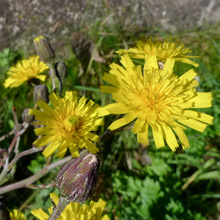
|
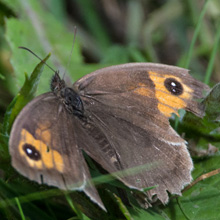
|
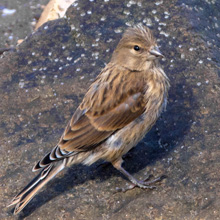
|
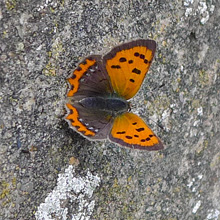
|
Inevitably
I spooked the Small Copper only to come across a well camouflaged
Blue Mason Bee as it probed the many tiny holes in the wall. It was
probably looking to use its building or " masonry " skills using using
mud and small stones to prepare a nest in the cracks or pits in the
wall. As I stalked the Bee, a Lime-speck Pug moth fixed itself to the
top of the wall looking to the casual glance very much like a bird
dropping. Next we came upon a patch of Sea Plantain. In some parts of
the world the leaves and seeds of this plant are eaten. The seeds can
be ground into flour. As we slowly progressed east a lonely
Black-headed Gull stood motionless on the sand.
Blue Mason Bee
|
Lime-speck Pug moth
|
Sea Plantain
|
Black headed Gull
|
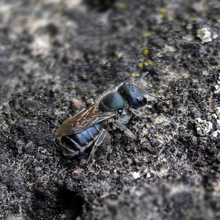
|
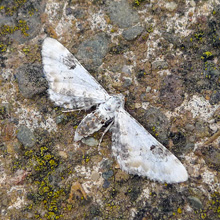
|
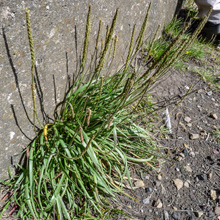
|
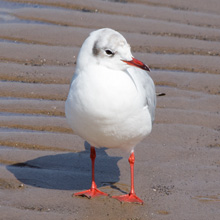
|
We saw lots of white birds in the distance diving into the sea. They were
Gannets and Terns, and by the creaking calls, Sandwich Terns. These
Terns, named after Sandwich, Kent, are also identifiable by the yellow tip to
their bill. The Gannets were probably after the Mackerel while it was likely
the Terns were hunting Sandeels, Sprat or Whiting. Below the seawall adjacent
to the Scrapes I spotted some Turnstones foraging along the rocky shoreline.
Apparently they are opportunistic feeders and will feed on a very wide range of
foods – even dead humans! Hopefully they seldom taste that delicacy very often
at Musselburgh! When we arrived at the middle hide of Levenhall Scrapes we were
pleased to see there were quite a lot of birds – even although the tide was
very low. Closest to the hide were Black-tailed Godwits. These were probably
from Iceland and may have stayed briefly before moving on as far south as
Morocco.
Sandwich Tern
|
Gannet
|
Turnstone
|
Black-tailed Godwit
|
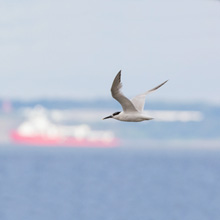
|
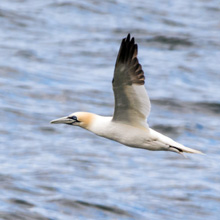
|
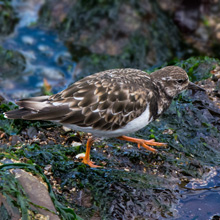
|
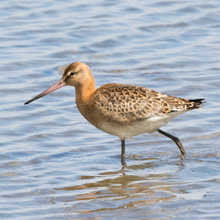
|
Just as I captured images of one of the many feeding Redshanks, a family of
Shelduck flew in. The flock was made mainly of juveniles. As I photographed
them I noticed a solitary bird resting on a solitary green leg (or “shank”). It
was a Greenshank sleeping at the back of the most easterly scrape. Suddenly the
Shelducks took to the air and circled the reserve several times before resting
on the middle scrape. They feed on small invertebrates, small fish and even
amphibians – so perhaps these were in short supply in the other scrape – or,
maybe like our youngsters, they were just restless and impatient.
Redshank
|
Juvenile Shelduck
|
Greenshank
|
Shelduck
|
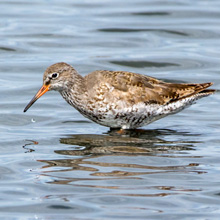
|
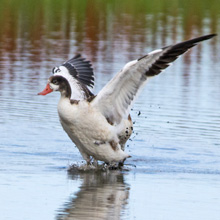
|
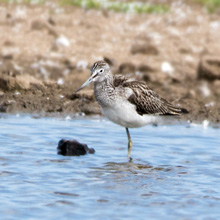
|
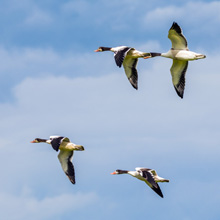
|
On our return journey back to the car we seemed to have been followed by a large
Herring Gull (Larus argentatus - Latin for “silver-decorated gull”) probably
looking for easy pickings. A pair of Linnets, adult male with juvenile, on the
seawall seemed to toy with me as I tried to edge closer to them to get a better
shot. They fled a little further away each time I tiptoed nearer to them. As
the light worsened, my final capture was of a juvenile male Eider hunting on
its own not far off the seawall.
Herring Gull
|
Linnet
|
Juvenile Linnet
|
Juvenile Eider
|
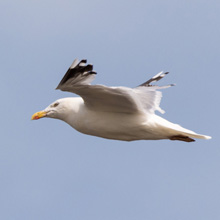
|
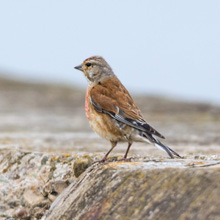
|
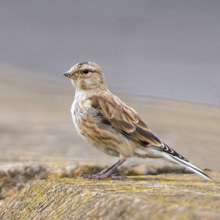
|
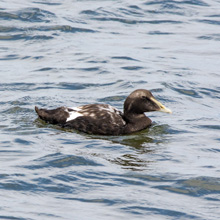
|
It was back to the car and very tasty Apple Lattice pastries with our teas,
followed by a homeward journey listening to the first Sunday EPL football of
the new season. Already?
Pictures of the week:
Perennial Sow Thistle
|
Linnet
|
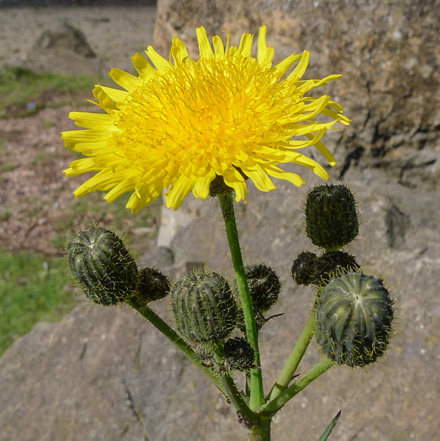
|
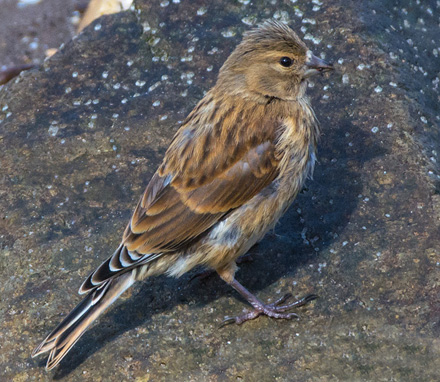
|
| Turnstone |
Black-tailed Godwit |
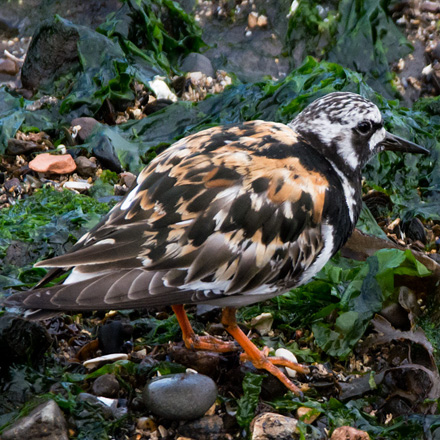
|
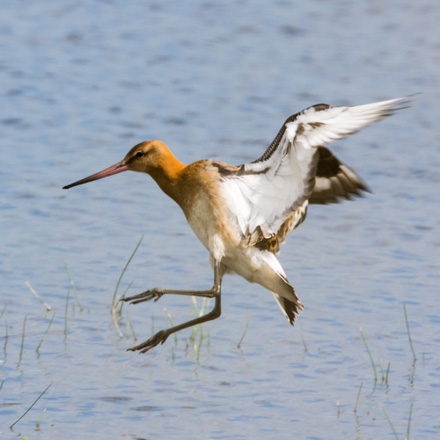
|
6th August 2017
Skateraw and Dunbar
We found ourselves at Skateraw, with view
to the east dominated by the Torness nuclear power station – so it's lovely if
you look north, south and west! The weather was dull and mild with the odd
shaft of sunlight. Our first sighting was of a family of Shelduck we had first
seen a month or so ago. Of course the chicks were now a lot bigger and fewer –
we counted only 4, about half seemed not to have made it. We set off for a walk
around the bay. In the field adjacent to the beach I spotted many Chicory
plants with their bonny blue flowers. Amongst them a Teasel head was being
feasted on by a 6-spotted Burnet moth. As we passed the house a Pied Wagtail
landed on the roof and watched that we had passed before returning to the beach
to forage.
Juvenile Shelduck
|
Chicory
|
Teasel / 6 Spot Burnet Moth
|
Pied Wagtail
|
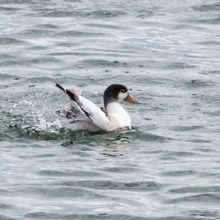
|
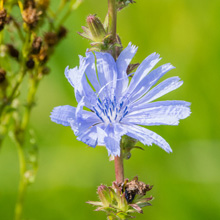
|
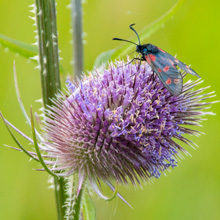
|
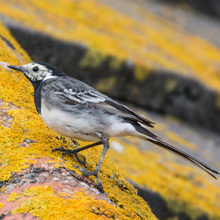
|
Further along I saw some Yarrow beside a
patch of Wild Roses, many of the flowers having turned to hips. I photographed
a fungus, Peeling Puffball that was nestling the short grass.
Yarrow
|
Wild Rose
|
Wild Rose Fruit
|
Peeling Puffball
|
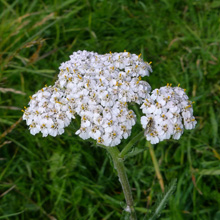
|
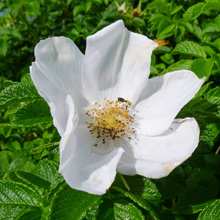
|
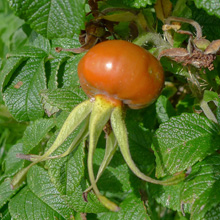
|
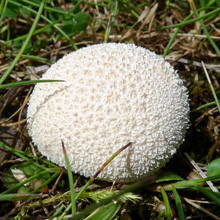
|
At the sea shore by the monument
at Chapel Point I was snapping some shots of Common Knapweed when a
female Shelduck passed overhead. It was probably the mother of the
family we'd seen earlier. On the rocky shore Sea Mayweed and Birdsfoot
Trefoil were nestled in spots sheltered from the wind. On Common
Ragwort John spotted Cinnabar moth caterpillars (see Pictures of the
Week, below).
Common Knapweed
|
Female Shelduck
|
Sea Mayweed
|
Common Birdsfoot Trefoil
|
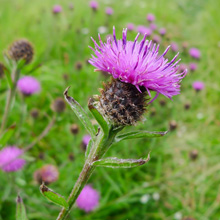
|
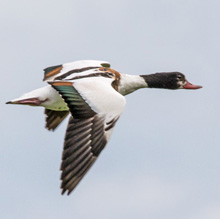
|
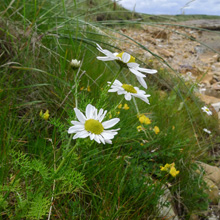
|
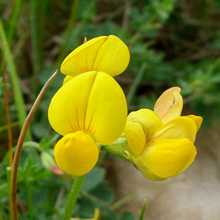
|
Offshore a lonely female Eider sat
bobbing up and down in the sea. A few Sanderling darted past it as they
sought a better roosting position on the rocks. Already anchored to the
large expanse of rock were some Curlew who were just far enough away
from the advancing waves. A large Cormorant had similar ideas as it
flew in from the sea.
Female Eider
|
Sanderling
|
Curlew
|
Cormorant
|
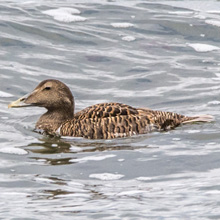
|
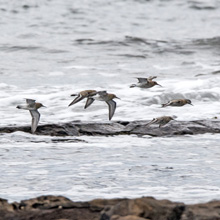
|
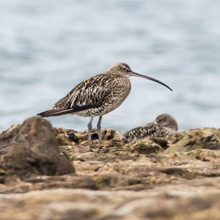
|
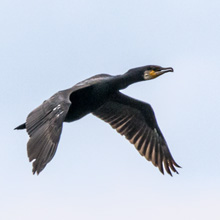
|
As we headed back
to the car we were overtaken by a flock of Feral Pigeons speeding around the
bay (again see Pictures of the Week, below) We decided to nip round to Dunbar
Harbour as it was a nice place to have our tea. When we arrived we were a bit
early for tea so we had a wee stroll around the Harbour to see what we could
see. A female House Sparrow sat obligingly on the sea wall as I tried my best
to get a good picture in the now quite gloomy light. A juvenile Cormorant made
a fly past travelling in from its roost on the offshore rocks. Young Kittiwakes
were testing out their flying skills around their nest sites on the Dunbar
Castle ruins. In the Harbour a fishing boat had just come in much to the
interest of a pair of Grey Seals. They were in luck as the fishermen chucked
scraps of fish overboard – this was much to the interest of the assembling
crowd of tourists who delighted in watching the seals’ antics.
House Sparrow
|
Juvenile Cormorant
|
Kittiwake
|
Grey Seal
|
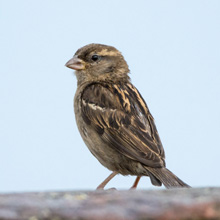
|
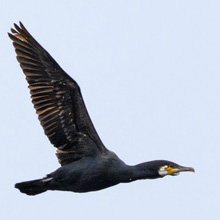
|
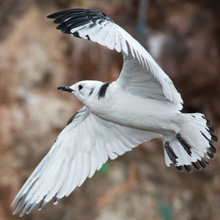
|
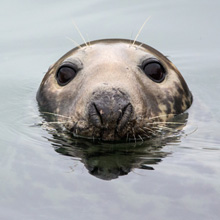
|
We noticed that Dunbar Battery was reopened after refurbishment. Amongst a
number of changes was the addition of a coastal garden (see https://dunbarbattery.org.uk/the-location/coastal-garden/
). Of the many plants there only a couple were in bloom, Balkan Clary And
Lavender Cotton. Not intentionally included in the developers’ plants list was
the Buckshorn Plantain growing on the Battery walls. Pretty in its own way. On
our way back to the car I noticed a lonely juvenile male Eider lurking on the harbour water.
Balkan Clary
|
Lavender Cotton
|
Buckshorn Plantain
|
Juvenile Eider
|

|
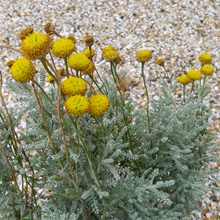
|
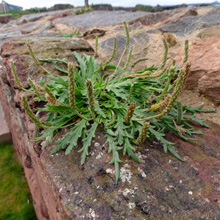
|
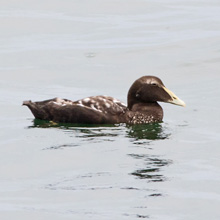
|
We indulged ourselves this week by having French fancies – 4 each (well they
were tiny- but lovely!)
Pictures of the Week:
Caterpillar - Cinnabar Moth
|
Feral Pigeon
|
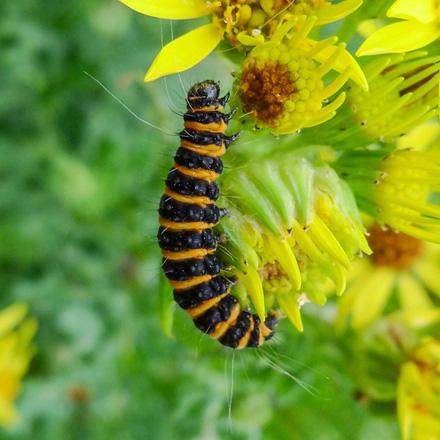
|
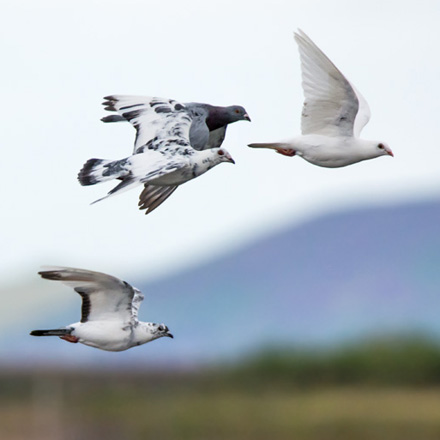
|
Grey
|
Seal
|
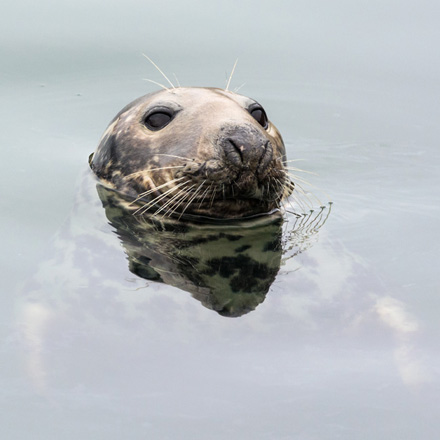
|
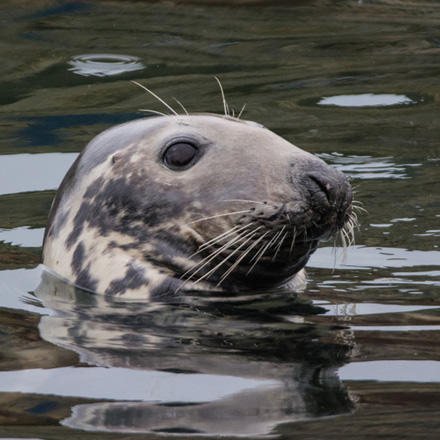
|
Back To Top
|

